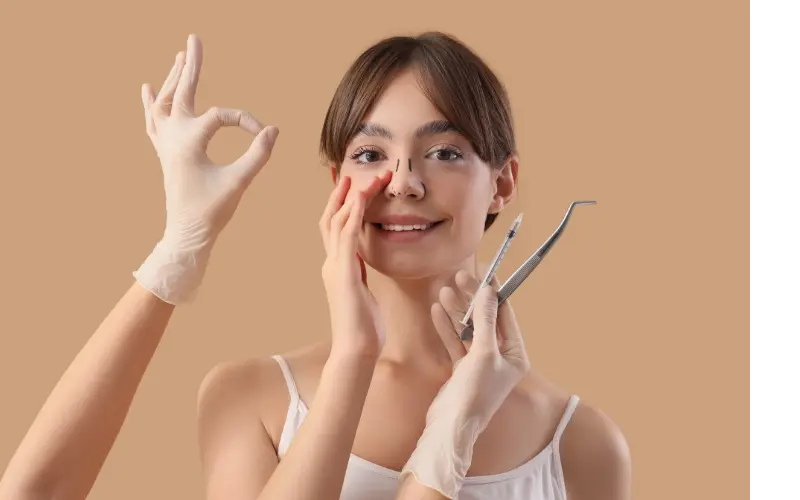Journal
How to Prepare Myself Before Surgery for Rhinoplasty in Korea?
2023-07-25
Nose

Overview
Nose surgery, known as rhinoplasty or nose job, is simply the process of altering the nose. The patient can alter the face's appearance with this occasionally stunning procedure. Most of the time, it is recommended for simply aesthetic purposes. However, it can also be "functional" for a person who has trouble breathing or restorative in the case of a broken or deviated nose from an accident.
- The primary flaws that rhinoplasty corrects are as follows:
- Bump (hump) on the nose
- An imbalance in the nose tip: too long or too broad
- Overly broad wings
- Too tiny nose
- Nasal septum deviation
The decision to undergo rhinoplasty is one that requires serious preparation and consideration. For those who have chosen South Korea as their destination for this life-changing procedure, preparation is the key to a positive experience. No matter if you are visiting Korea or you already live here, being well-prepared will increase your chances of having a successful surgery and make your trip less stressful.
Preparation #1:
Obtaining a nose that looks natural and complements the patient's facial characteristics and personality is the main objective of rhinoplasty. Thus, it is highly important to avoid making a snap decision to have a nose job. Knowing the rationale for this choice is crucial.
A successful rhinoplasty journey begins with choosing the best plastic surgeon and hospital. One great way to learn about a surgeon's abilities and the quality of services they provide in the clinic is to read through patient reviews. Reviews are more instructive than plain advertising and they do not lie. Check out the comments made regarding the surgical site's hygiene, the process itself, the doctor's abilities, and the practitioner's overall empathy.
Read reviews, conduct in-depth research, and ask reliable sources for recommendations. Seek out the name of the best rhinoplasty surgeon in Korea who has experience performing successful rhinoplasty procedures and is an expert in the field. Verify their qualifications, accreditations, and affiliations with reputable medical associations. Your primary objective should be an established medical facility with cutting-edge equipment and an emphasis on patient satisfaction and safety. If you select one surgeon over another, you will have a better sense of what to expect.
Preparation #2:
Once you've selected a prospective surgeon, set up a consultation to discuss your aesthetic goals, medical background, and concerns. Word of mouth is a great way to get objective opinions about the selected surgeon.
Your surgeon will evaluate your facial harmony, skin type, and nasal structure during this consultation to identify the best approach for your procedure. Be open and honest about your expectations as this will allow the surgeon to set realistic goals and manage your expectations effectively.
The trust that is developed between a cosmetic surgeon and their patients is just as important as their quality in training and expertise. Because it is founded on the surgeon's human qualities and grows throughout the initial consultation, this trusting relationship is crucial to the patient's journey.
During the consultation, you can assess the quality of the surgeon by asking yourself a few questions: is he understanding and attentive? Does he know about your health, lifestyle, and medical history? Does he also ask questions about your reasons for considering cosmetic surgery? Does he make sure you don't make snap decisions? It should also be easy for you to ask any queries that are on your mind. These are crucial characteristics of a competent surgeon.
Do not be afraid to inquire about the surgeon's experience and recommendations.
Examine their abilities both as a professional and as a person. Your doctor should inspire confidence in you, and ought to be engaged in your idea and provide you with active listening. A skilled surgeon will always take the time to consider the patient's goals and explain the benefits and drawbacks of any procedure. Sometimes, the surgeon may decide to perform a procedure different from what you had intended. With expertise in providing aesthetic care, the surgeon should strive to provide you with the greatest outcome without harming your health.
Preparation #3:
Educate yourself as much as you can about the rhinoplasty procedure steps, the potential risks involved, and the rhinoplasty recovery tips. Additionally, don't forget to look for Korean rhinoplasty before and after photos and videos to get more ideas on what having surgery in Korea will be like. A patient who is well-informed is better equipped to make wise decisions and actively engage in the treatment plan. You should receive comprehensive information from your surgeon regarding the procedure, its benefits, and any possible downsides. Take some time to clarify any aspects of the process that are unclear to you by asking questions.

Preparation #4:
Your surgeon will provide you with detailed pre-operative instructions that you must carefully follow in the weeks leading up to your surgery date. Guidelines for taking medications, drinking alcohol, smoking, and adhering to specific dietary restrictions may be included in these instructions. To reduce the possibility of complications and ensure the best outcome, it is essential to follow these guidelines.
If you have any issues or concerns, pay attention to your body, and don't be afraid to ask your doctor questions. To guarantee appropriate healing, take care of your incision and adhere to your surgeon's instructions. Do not hesitate to get in touch with your surgeon right away if you experience any issues or difficulties.
Keep in mind that you should talk to your doctor about any current medications you are taking prior to surgery. Before surgery, you might need to temporarily switch medications or stop taking some of them. In order to prevent complications during or after surgery, strictly adhere to your doctor's recommendations.

Preparation #5:
You'll require downtime for rhinoplasty recovery time, so it's critical to have a support system in place. If you are coming from outside of Korea, consider bringing a reliable friend or family with you. You may need them for emotional support, help with daily tasks, and keep an eye on your well-being while you go through the recovery process.
Preparation #6:
Prepare your living space with the necessary supplies for a comfortable recovery before your surgery. Stock up on soft foods, painkillers (per your surgeon's prescription), cold compresses, and items to occupy yourself during downtime. It's crucial to have a relaxing atmosphere to promote healing and recovery.
To ensure a successful and satisfying outcome, it is essential to prepare for rhinoplasty in Korea. Each step is important to your overall experience, from selecting a qualified surgeon and understanding the operation to following pre-operative instructions and making plans for a speedy recovery. By taking the time to research, communicate effectively with your surgeon, and prepare both mentally and physically, you can embark on your rhinoplasty journey in South Korea with confidence and excitement for the transformative results that lie ahead.
FAQ
Post-operative care and procedure safety are of utmost importance to Docfinderkorea’s partner clinics. A document including postoperative instructions unique to your surgery will be given to you after the procedure. For best results, you have to adhere to them exactly. It is generally recommended that you avoid bending forward or lifting big objects because they can lead to bleeding.
Your face will be bruised and swollen around the eyes following the procedure. This might go on for a few weeks. You should think about this if you want to work or participate in social activities. Usually, it takes two weeks before you go back to your job. This is the time when most recuperation occurs. In a few months, the swelling entirely goes away. You won't be able to view the finished product of the bridge or nose tip surgery until then. Therefore, if the outcome does not reach your expectations during the first few weeks, you shouldn't be frightened because this will change over time.
Why am I going to be requested to fast food and liquids after midnight the night before the procedure?
Medication used for anesthesia may upset your stomach. The best defense against anesthesia side effects is to abstain from meals and liquids starting at midnight the night before the surgery.
What potential side effects are there from rhinoplasty?
The following are a few potential side effects of nose surgery, but they're not exclusive:
- Sickness
- Runny nose
- Hole in the nasal septum
- Nasal hump
- Persistent blockage of the nose
- Persistent deviation of the nose
- The presence or persistence of an aesthetic flaw (which could need to be fixed again after a year)
- Issues with anesthesia
What are the surgery's potential short-term side effects?
- To help keep the nose in its new shape, a stiff splint may be placed on it
- To stabilize the septum, soft silicone splints can be inserted inside the nostrils and remain there for ten to fifteen days.
- In case of bleeding, nose packing might be put inside the nose for a maximum of 48 hours.
- Particularly in the initial month following a rhinoplasty, the nose may be uncomfortable and swollen.
- Headaches, swelling, and/or bruises surrounding the eyes.
- It's typical to have bloody nasal discharge during the initial days.
Why I should use Docfinderkorea?
Post-surgery meal- what to eat & what to avoid?
Where to go in Seoul during the recovery period?
Back


